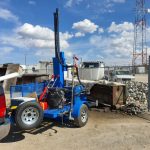Why does the Bank require an Environmental Site Assessment report?
This is an all too common question we get from our prospective clients. It is a good question as there is an expense involved to the client or seller of the property or whoever may be leasing the property. In our time undertaking Phase 1 Environmental Site Assessments (Phase 1 ESA’s) in Calgary and Edmonton and right throughout Alberta we have seen many different situations where a Phase 1 ESA assists a client to protect them against liability and risk.
At the bottom of this article is a link to an excellent article by the Business Development Bank of Canada (BDC). This article outlines a good summary of the aspects of a Phase 1 ESA along with the benefits of undertaking a Phase 1 ESA and the risks of not undertaking such an assessment. In short however the purpose of a Phase 1 ESA is to evaluate where there is likely to be actual or potential contamination impacting or on a property. Banks such as RBC, BDC, TD, BMO, ATB, CIBC and HSBC all generally require a Phase 1 Environmental Site Assessment when lending on properties which may have a risk of contamination. The reason they require a Phase 1 ESA for a mortgage on a property is that the asset under the mortgage, until paid off, is often largely owned by the bank. Therefore, the aim for the bank is protection to ensure they are not lending money on what may be a liability. This can occur if for example you are purchasing a property for $500,000 which has a contamination issue with costs for example $100,000 to clean up. This is why the banks require a Phase 1 ESA. They wish to limit their exposure to an asset which has significant liabilities.
As a potential purchaser you also want to know if the property you are going to purchase is contaminated. Whether you are lucky enough to be able to purchase with cash or require a mortgage, if the property is found to be contaminated once you purchase it then you own that contamination. While in some cases it is possible to chase the previous owner on neighboring owners who may have created the contamination problem this is often fruitless and is extremely expensive.
Sellers of property, particularly commercial properties and farmland benefit from having a current Phase 1 ESA to provide to potential purchasers. Potential purchasers are often reluctant to spend the money for a Phase 1 ESA on a property if there is a similar property available which already has a Phase 1 ESA report available. This often enables multiple offers on an industrial property as it is clear to all potential purchasers that the site does not have a risk of contamination being present.
In many cases it is part of a commercial lease agreement that the property is left in the same condition as when the lease was written. Some leases have clauses that the property must not be contaminated by any activity. The issue for a business or individual entering into a lease however is that the property may potentially already have contamination present. As such it is best to always undertake a Phase 1 ESA when taking on a rental lease particularly for a commercial property so you know if the property has been contaminated by a previous tenant. If you do not protect yourself by undertaking this type of assessment (often as an elevated Phase 1 ESA with some sampling) you run the risk that you may be exposed to having to clean up a site you never contaminated.
So, a Phase 1 ESA represents a sound investment. As Environmental Consultants based in Alberta and also covering British Columbia we are well placed to service our clients in the West.
Why not give us a call today and let us assist you with your next project.
Also please take the time to read this excellent article from BDC which provides a sound level of detail on Phase 1 Environmental Site Assessments.



